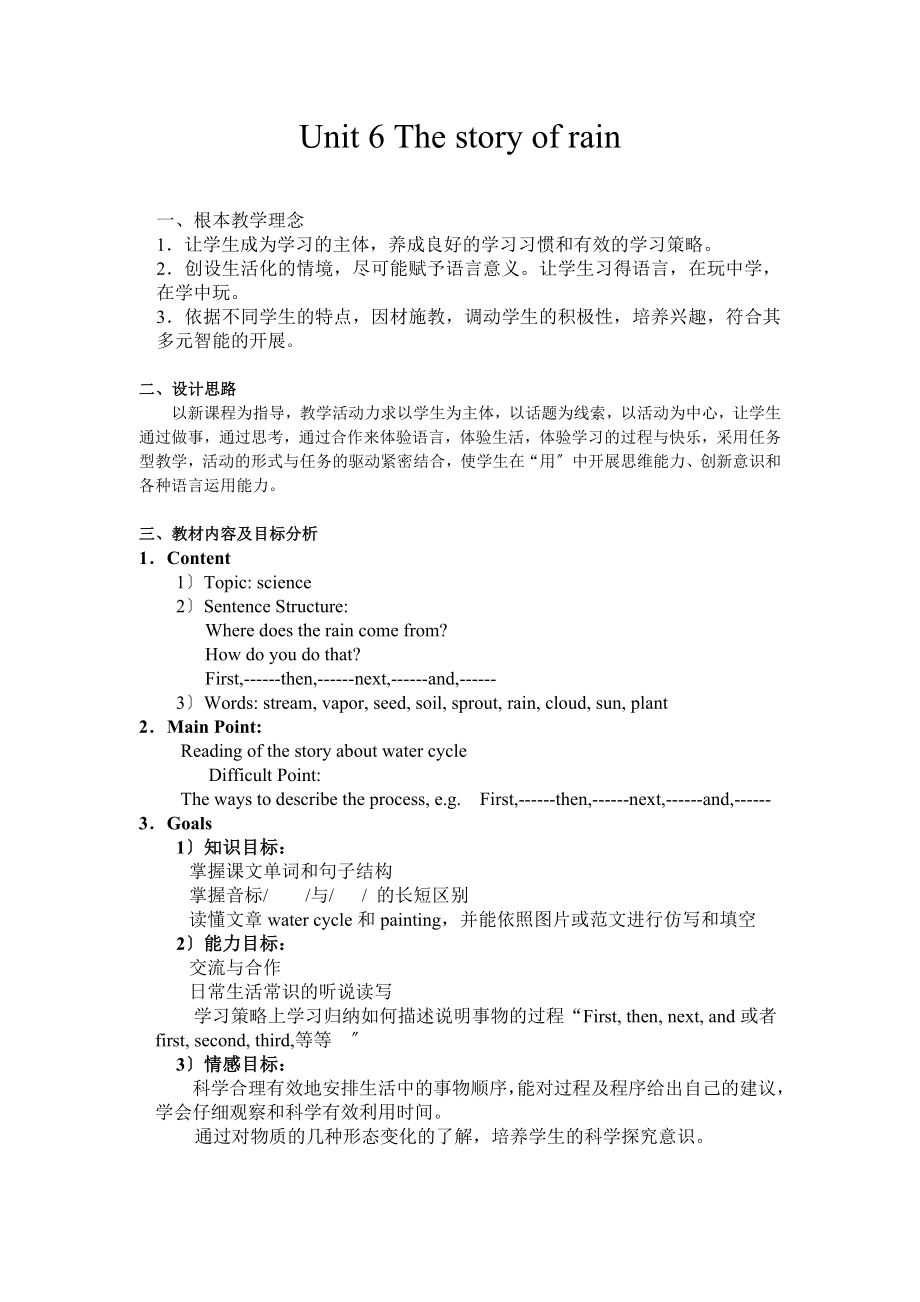《【小學(xué) 六年級(jí)英語】新課標(biāo)PEP小學(xué)英語六年級(jí)上冊(cè)全冊(cè)教案 共(4頁)》由會(huì)員分享���,可在線閱讀���,更多相關(guān)《【小學(xué) 六年級(jí)英語】新課標(biāo)PEP小學(xué)英語六年級(jí)上冊(cè)全冊(cè)教案 共(4頁)(6頁珍藏版)》請(qǐng)?jiān)谘b配圖網(wǎng)上搜索�����。
1��、Unit 6 The story of rain
一���、根本教學(xué)理念
1.讓學(xué)生成為學(xué)習(xí)的主體,養(yǎng)成良好的學(xué)習(xí)習(xí)慣和有效的學(xué)習(xí)策略����。
2.創(chuàng)設(shè)生活化的情境,盡可能賦予語言意義�����。讓學(xué)生習(xí)得語言���,在玩中學(xué)�,在學(xué)中玩�。
3.依據(jù)不同學(xué)生的特點(diǎn),因材施教���,調(diào)動(dòng)學(xué)生的積極性���,培養(yǎng)興趣���,符合其多元智能的開展。
二�����、設(shè)計(jì)思路
以新課程為指導(dǎo)���,教學(xué)活動(dòng)力求以學(xué)生為主體��,以話題為線索�,以活動(dòng)為中心��,讓學(xué)生
通過做事����,通過思考,通過合作來體驗(yàn)語言�,體驗(yàn)生活��,體驗(yàn)學(xué)習(xí)的過程與快樂,采用任務(wù)型教學(xué)���,活動(dòng)的形式與任務(wù)的驅(qū)動(dòng)緊密結(jié)合�,使學(xué)生在“用〞中開展思維能力��、創(chuàng)新意識(shí)和各種語言運(yùn)用能力��。
2�、
三、教材內(nèi)容及目標(biāo)分析
1.Content
1〕Topic: science
2〕Sentence Structure:
Where does the rain come from?
How do you do that?
First,------then,------next,------and,------
3〕Words: stream, vapor, seed, soil, sprout, rain, cloud, sun, plant
2.Main Point:
Reading of the story about water cycle
Difficult
3���、Point:
The ways to describe the process, e.g. First,------then,------next,------and,------
3.Goals
1〕知識(shí)目標(biāo):
掌握課文單詞和句子結(jié)構(gòu)
掌握音標(biāo)/ /與/ / 的長短區(qū)別
讀懂文章water cycle和painting����,并能依照?qǐng)D片或范文進(jìn)行仿寫和填空
2〕能力目標(biāo):
交流與合作
日常生活常識(shí)的聽說讀寫
學(xué)習(xí)策略上學(xué)習(xí)歸納如何描述說明事物的過程“First, then, next, and或者first, second, third,等等 〞
3〕情感目標(biāo)
4���、:
科學(xué)合理有效地安排生活中的事物順序��,能對(duì)過程及程序給出自己的建議��,學(xué)會(huì)仔細(xì)觀察和科學(xué)有效利用時(shí)間���。
通過對(duì)物質(zhì)的幾種形態(tài)變化的了解�,培養(yǎng)學(xué)生的科學(xué)探究意識(shí)���。
四���、教學(xué)建議
按照A局部〔水循環(huán)〕、B局部〔植物種植過程〕設(shè)計(jì)如下內(nèi)容���。
Lesson 1
Let’s start Let’s learn let’s find out
Step1 warm up
Let’s sing a song: My family
Greetings: Hello, where are you come from ?
Step 2
5����、Presentation
1.詞匯導(dǎo)入:
1〕泉水叮咚:聽各種水的聲音�����,從情感上感受����,猜猜是什么,引出water��。
2〕歌謠接龍:Rain, rain, where are you going?
Going to the … (river, lake, sea, ocean, waterfall, stream) 引出stream�����。
歌謠:
Rain, rain, where are you going?
Going to the lake, going to the sea.
Going to the farm, going to the field.
Going to
6、 the river, going to the stream.
3〕浮想聯(lián)翩:圖片提示��,表演操練:I’m the water in the … , I’m…讓學(xué)生想象自己是各種狀態(tài)下存在的水分子.引出vapor����。
2. 經(jīng)典提問:以“雞生蛋����,蛋生雞〞為例:?jiǎn)枌W(xué)生Egg, egg, where do you come from?再轉(zhuǎn)而問雞: Chicken, chicken, where do you come from? 引出come from和 comes . from。
Teacher draw a egg on the backboard and ask : Where does
7����、 it come from ?
Ss : It comes from chicken .
T : Where does the chicken come from ?
Ss : It comes from egg .
3. 毛驢磨磨:以水循環(huán)water, rain, stream, cloud, vapor的形成為例,問其來歷�,通過簡(jiǎn)筆畫的表述,形成一個(gè)循環(huán)���。
Teach : rain ; cloud ; sun ; stream
4. 窮追不舍:
目的:把詞匯結(jié)合在對(duì)話中����,使其不為獨(dú)立的個(gè)體��,讓學(xué)生感受真正的語言環(huán)境。
設(shè)問如下:Wh
8�����、at’s in the stream?
What can you do in the stream?
Why? ------Don’t…in the stream.
Where can you see the vapor?
What can vapor do?
2〕聯(lián)盟聯(lián)想:
目的:培養(yǎng)思維的發(fā)散性能力�。
如:讀所給單詞,你能想出多少個(gè)與它有關(guān)的單詞�?請(qǐng)寫在箭頭后,并說一說���。
vapor
hot
����、
water
trees
1〕學(xué)生寫完后說的時(shí)候以句子形式出現(xiàn)����,
9、如The water is hot. It is vapor now.
2〕可以將全班分組,進(jìn)行小組比賽���。
3〕此活動(dòng)也可以將單詞改為句子進(jìn)行���。
句型:Where does it come from? It comes from…
5. let’s find out
What can you see in the picture ?
Step 3.Do listening exercises.
Ss listen to the tape and do exercises in the activity book.
Step 4.Homework
教學(xué)反思:
10、
小學(xué)六年級(jí)英語試題
一����、按要求改寫單詞:
1. she________(賓格) 2. country_________〔復(fù)數(shù)〕 3. close__________(現(xiàn)在分詞)
4. three________(序數(shù)詞) 5. China__________〔形容詞〕 6. I _______ 〔名詞性物主代詞〕
7. paper ______(復(fù)數(shù)) 8. swim ________〔現(xiàn)在分詞〕 9.photo________〔復(fù)數(shù)〕
10.mouse_______(復(fù)數(shù)) 11.mango________(復(fù)
11�����、數(shù)) 12.make________(現(xiàn)在分詞)
二���、選擇題:
( ) (1). I get up _______ about seven fifty -five .
A. in B. on C. at D. for
( ) (2). Why are you looking at _______like that?
A. I B. mine C. my D. me
( ) (3). I want _______ a map of China .
A. buy B. is buying C. to buy D. am buying
(
12���、) (4). Is it a picture ______ your school �����?
A. of B. to C. and D. with
( ) (5). Do you like _______ ?
A. swim B. swimming C. are swimming D. swim, too
( ) (6). The man ______ a book in his hand is my uncle .
A. and B. of C. with D. for
( ) (7). Who’s the lady ______ blue ?
A. in
13�����、B. on C. at D. with
( ) (8). We usually stay _____ home ____ Saturday afternoon .
A. at…in B. at…on C. in…at D. on…on
( ) (9). A: It’s a white shirt , is it yours ? B: No, ____ is yellow .
A. I B. My C. Mine D. Me
( ) (10). ______ any men in the room ?
A. Is there B. Are there C. T
14�����、here aren’t D. There isn’t
( ) (11). The bed ______ the right is yours .
A. on B. in C. at D. of
( ) (12). Look at _______ picture .
A. one B. the one C. first D. the first
( ) (13). These books are my _______ .
A. students B. students’s C. students’ D. students of
( ) (14). My
15����、 parents often tell me ______ your family .
A. about B. from C. for D. by
( ) (15). ______ any food in the fridge ?
A. Are there B. Is there C. Have D. Has
三����、按要求改寫句子,注意每條橫線只填一個(gè)單詞:
1. The children like the ball . 〔改為一般疑問句〕
______ the children ________ the ball ?
2. Are these you
16���、r pens ? 〔不改變?cè)湟馑?����,改寫句子?
Are these ______ _________ ?
3. Please put the clothes here .(改為否認(rèn)句)
________ put the clothes here, ________ .
4. They get up at six thirty .(就劃線局部提問)
What _______ _________ they get up ?
四����、聯(lián)詞成句:
1. the, read, in, don't, sun, please _______________
17���、__________________
2. sisters, brothers, you, any, or, got, have? _________________________________
3. black, all, like, I, at, don’t _________________________________
4. can, do, I, for, what, you? _________________________________
5. drink, like, something, you, to, would? ________________
18����、__________________
五���、用所給的動(dòng)詞的適當(dāng)形式填空:
1 . Look ! My sister _________ ( play ) with the toy cars .
2 . I _______ ( get ) up at 6:30 every morning .
3 . Do they like ________ (swim) ?
4 . Tom’s mother _______ (have) a nice jacket .
5 . Can you _______ (make ) a paper plane for me ?
 【小學(xué) 六年級(jí)英語】新課標(biāo)PEP小學(xué)英語六年級(jí)上冊(cè)全冊(cè)教案 共(4頁)
【小學(xué) 六年級(jí)英語】新課標(biāo)PEP小學(xué)英語六年級(jí)上冊(cè)全冊(cè)教案 共(4頁)

